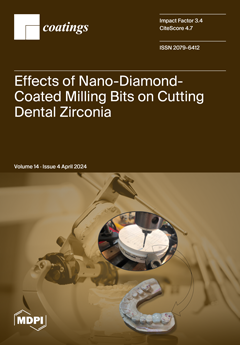The (TiNbZrCr)N
x high-entropy nitride films (HENFs) were prepared by high-power pulsed magnetron sputtering (HPPMS). The effect of the N
2 flow rate (F
N) on the HPPMS plasma discharge, film composition, microstructure, residual stress, tribological properties, and corrosion resistance was investigated.
[...] Read more.
The (TiNbZrCr)N
x high-entropy nitride films (HENFs) were prepared by high-power pulsed magnetron sputtering (HPPMS). The effect of the N
2 flow rate (F
N) on the HPPMS plasma discharge, film composition, microstructure, residual stress, tribological properties, and corrosion resistance was investigated. Results show that, with the increase in F
N, plasma discharge is enhanced. Firstly, the introduced N atoms react with Ti, Nb, Cr, and Zr to form an FCC nitride phase structure. Then, with the increase in plasma bombardment on the deposited film, the HENFs undergo amorphization to form an FCC+ amorphous structure, accompanied by a decrease in grain size and a change in the preferred orientation from (1 1 1) to (2 0 0). The HENFs deposited at F
N = 8 sccm show the highest hardness of 27.8 GPa. The HENFs deposited at F
N = 12 sccm present the best tribological properties, with a low wear rate of 4.0 × 10
−6 mm
3N
−1m
−1. The corrosion resistance of the (TiNbZrCr)N
x HENFs shows a strong correlation with the amorphous phase. The corrosion resistance of the FCC nitride film is the worst, and the corrosion resistance gradually increases with the amorphous transformation of the film. Based on the above results, nanocomposite high-entropy films can be prepared using HPPMS technology and exhibit excellent, comprehensive performance.
Full article





